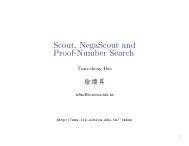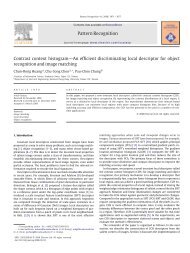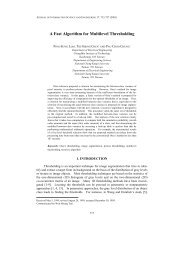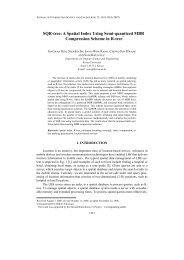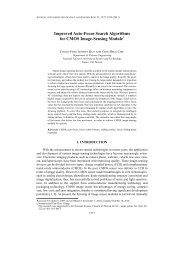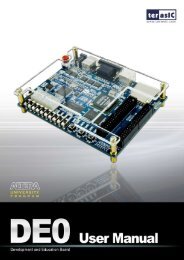An error resilient coding scheme for H.264 video transmission based ...
An error resilient coding scheme for H.264 video transmission based ...
An error resilient coding scheme for H.264 video transmission based ...
Create successful ePaper yourself
Turn your PDF publications into a flip-book with our unique Google optimized e-Paper software.
3.2. Error <strong>resilient</strong> <strong>coding</strong> <strong>for</strong> <strong>H.264</strong> P frames<br />
For an MB in a P frame, two types (Type-I and Type-II)<br />
of important data will be extracted and embedded. The<br />
Type-I data <strong>for</strong> an MB contains the <strong>coding</strong> mode, the<br />
reference frame(s), and the MV(s) <strong>for</strong> the MB, whereas<br />
the Type-II data <strong>for</strong> the MB includes the best EC <strong>scheme</strong><br />
among 15 evaluated EC <strong>scheme</strong>s <strong>for</strong> the MB.<br />
For the Type-I data of an MB, one bit is used to denote<br />
whether the Type-I data will be embedded. If the Type-I<br />
data will be embedded, one bit is used to denote its <strong>coding</strong><br />
mode (skip or inter-coded). Note that the rarely-used<br />
intra-coded mode is ignored here. For an inter-coded MB,<br />
2 bits are used to denote which inter-coded mode (inter-<br />
1616, inter-168, or inter-816) is used. <strong>An</strong>y of the<br />
other inter-coded modes containing many MVs is ignored<br />
here. For an MB (inter-1616) or subblock (inter-168 or<br />
inter-816), 2 bits are used to denote the reference frame<br />
(3 reference frames are used here, i.e., S = 3) and one bit<br />
is used to denote whether the MV is a zero MV. For an<br />
MB or subblock with a non-zero MV, 16 bits are used to<br />
denote one MV with the search range set to 16 pixels<br />
(quarter pixel accuracy). Note that <strong>for</strong> an ignored intracoded<br />
MB or an ignored inter-coded MB, only one bit<br />
denoting that no Type-I data is embedded.<br />
For the Type-II data of an MB, 15 simple EC <strong>scheme</strong>s<br />
will be evaluated at the encoder and the best one among<br />
15 is extracted as its important data (4 bits). The 15 EC<br />
<strong>scheme</strong>s are as follows. (1) Three zero-MV techniques, in<br />
which the three MBs at the corresponding spatial<br />
locations in the three reference frames are copied to<br />
conceal the corrupted MB, respectively. (2) Three<br />
average-MV techniques. If the 8-connected spatially<br />
neighboring MBs of the corrupted MB are denoted by Bi,<br />
1 i 8 and 3 reference frames are used, i.e., S = 3, all<br />
the MVs of Bi’s will locate on the three reference frames.<br />
Then, the average MV, mvs,av, on the sth reference frame<br />
of the MVs of the 8-connected spatially neighboring MBs<br />
of the corrupted MB can be denoted as mvs,av, s = 1, 2, 3.<br />
The three motion-compensated MBs with the three MVs,<br />
mvs,av, s = 1, 2, 3, are used to conceal the corrupted MB,<br />
respectively. (3) Assume that the <strong>coding</strong> mode of a<br />
corrupted MB is inter-168 and the top (bottom) 168<br />
subblock can be concealed by the three average-MV<br />
techniques with mvs,av, s = 1, 2, 3, which are evaluated<br />
over the half top (bottom) of the 8-connected “believable”<br />
spatially neighboring MBs (subblocks), respectively.<br />
Hence, there are nine possible combinations, i.e., nine EC<br />
<strong>scheme</strong>s. As a summary, the MAEs between the <strong>error</strong>-free<br />
MB and the 15 “pre-concealed” MBs using the 15 EC<br />
algorithms are evaluated. The best EC <strong>scheme</strong> with the<br />
minimum MAE is finally extracted as the Type-II data <strong>for</strong><br />
the MB.<br />
<br />
For an MB in a P frame, the important data will be<br />
embedded by using the proposed MB-interleaving slice<strong>based</strong><br />
data embedding <strong>scheme</strong>, in which the important<br />
data <strong>for</strong> all the MBs in a slice will be embedded into the<br />
four corresponding “masking” slices in the next frame.<br />
Hence, <strong>for</strong> example, the Type-I data <strong>for</strong> the even-number<br />
MBs of the first slice, the Type-I data <strong>for</strong> the odd-number<br />
MBs of the third slice, the Type-II data <strong>for</strong> the evennumber<br />
MBs of the fifth slice, and the Type-II data <strong>for</strong> the<br />
odd-number MBs of the seventh slice are interleaved and<br />
concatenated to a mixed bitstream, which is embedded<br />
into its masking slice in the next frame. Here, the oddeven<br />
data embedding <strong>scheme</strong> [5] is also employed to<br />
embed the important data. For an MB in a P frame, the<br />
data size of the Type-I data is at most 42 bits, which is<br />
sometimes too large to be embedded. Hence, be<strong>for</strong>e<br />
embedding the Type-I data, the priority <strong>for</strong> an MB will be<br />
determined by the MAE between the <strong>error</strong>-free MB and<br />
the “pre-concealed” MB by using the corresponding best<br />
EC <strong>scheme</strong>. The larger the MAE is, the higher the priority<br />
of the MB will be. Then, the Type-I data <strong>for</strong> the two MBs<br />
with the lowest priorities will be ignored, i.e., replaced by<br />
one bit denoting that no Type-I data is embedded.<br />
However, the Type-II data <strong>for</strong> each MB will be always<br />
embedded.<br />
At the decoder, the masking slice <strong>for</strong> a corrupted MB<br />
is determined and its important data will be extracted if its<br />
masking slice is correctly received. Then, if the <strong>coding</strong><br />
mode is skip, the corresponding MB in the previous frame<br />
is used to conceal the corrupted MB. If the <strong>coding</strong> mode is<br />
inter-coded, the <strong>coding</strong> mode, reference frame(s), and<br />
MV(s) are together used to conceal the corrupted MB. If<br />
(1) no Type-I data is embedded or (2) the Type-I data<br />
cannot be correctly extracted and the Type-II data are<br />
available, the best EC <strong>scheme</strong> is used to conceal the<br />
corrupted MB. If no important data is available, the<br />
average MV, MVav, of the MVs of the “believable” 8connected<br />
neighboring MBs of the corrupted MB is<br />
computed. If the magnitude of MVav, |MVav|, is smaller<br />
than the predefined threshold, TMV, the corrupted MB is<br />
concealed by the Zero-MV BNM algorithm (select the<br />
best one on 3 reference frames). Otherwise, the motioncompensated<br />
BNM algorithm with mvs,av, s = 1, 2, 3 on 3<br />
reference frames (select the best one) is used to conceal<br />
the corrupted MB. Note that be<strong>for</strong>e concealing a<br />
corrupted MB by using the Type-II data or the employed<br />
EC <strong>scheme</strong> <strong>for</strong> P frames, its 8-connected neighboring<br />
corrupted MBs can be concealed first if they can be<br />
concealed with the correctly extracted Type-I data. Then,<br />
the corrupted MB can be concealed by using the best or<br />
employed EC <strong>scheme</strong> with more neighboring MB<br />
in<strong>for</strong>mation.<br />
4. SIMULATION RESULTS



